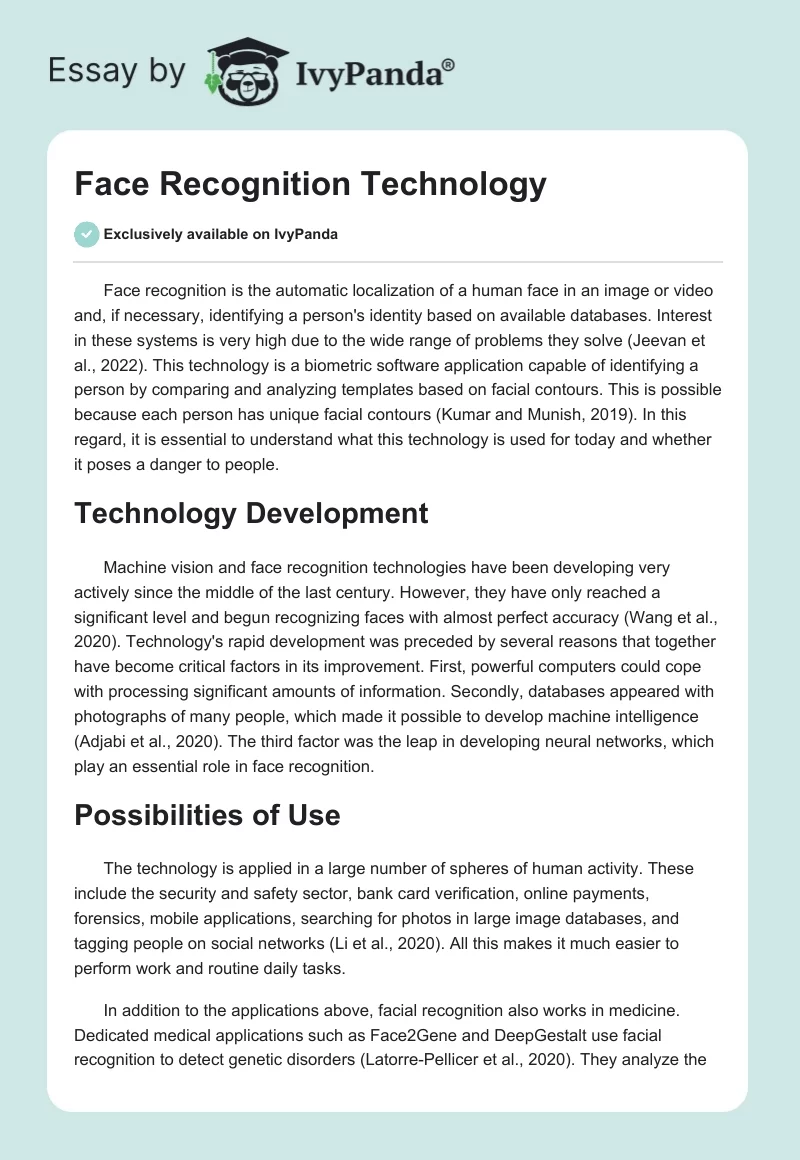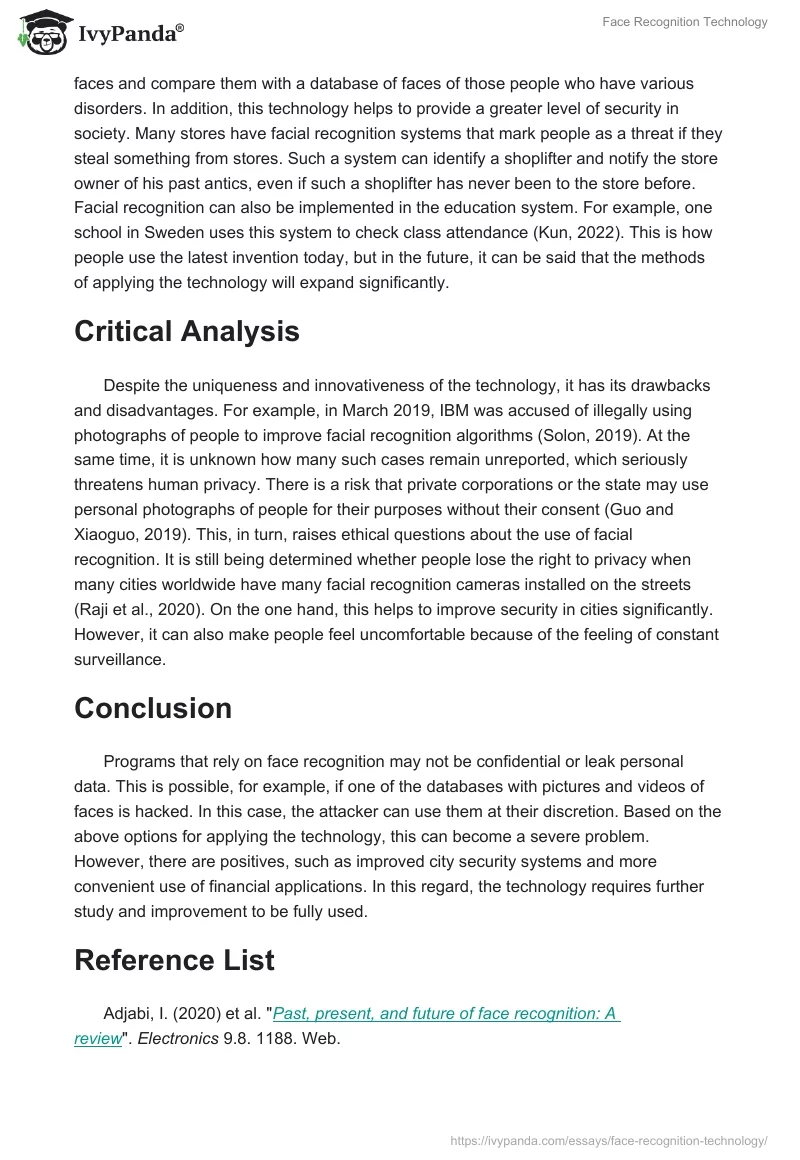Face recognition is the automatic localization of a human face in an image or video and, if necessary, identifying a person’s identity based on available databases. Interest in these systems is very high due to the wide range of problems they solve (Jeevan et al., 2022). This technology is a biometric software application capable of identifying a person by comparing and analyzing templates based on facial contours. This is possible because each person has unique facial contours (Kumar and Munish, 2019). In this regard, it is essential to understand what this technology is used for today and whether it poses a danger to people.
Technology Development
Machine vision and face recognition technologies have been developing very actively since the middle of the last century. However, they have only reached a significant level and begun recognizing faces with almost perfect accuracy (Wang et al., 2020). Technology’s rapid development was preceded by several reasons that together have become critical factors in its improvement. First, powerful computers could cope with processing significant amounts of information. Secondly, databases appeared with photographs of many people, which made it possible to develop machine intelligence (Adjabi et al., 2020). The third factor was the leap in developing neural networks, which play an essential role in face recognition.
Possibilities of Use
The technology is applied in a large number of spheres of human activity. These include the security and safety sector, bank card verification, online payments, forensics, mobile applications, searching for photos in large image databases, and tagging people on social networks (Li et al., 2020). All this makes it much easier to perform work and routine daily tasks.
In addition to the applications above, facial recognition also works in medicine. Dedicated medical applications such as Face2Gene and DeepGestalt use facial recognition to detect genetic disorders (Latorre-Pellicer et al., 2020). They analyze the faces and compare them with a database of faces of those people who have various disorders. In addition, this technology helps to provide a greater level of security in society. Many stores have facial recognition systems that mark people as a threat if they steal something from stores. Such a system can identify a shoplifter and notify the store owner of his past antics, even if such a shoplifter has never been to the store before. Facial recognition can also be implemented in the education system. For example, one school in Sweden uses this system to check class attendance (Kun, 2022). This is how people use the latest invention today, but in the future, it can be said that the methods of applying the technology will expand significantly.
Critical Analysis
Despite the uniqueness and innovativeness of the technology, it has its drawbacks and disadvantages. For example, in March 2019, IBM was accused of illegally using photographs of people to improve facial recognition algorithms (Solon, 2019). At the same time, it is unknown how many such cases remain unreported, which seriously threatens human privacy. There is a risk that private corporations or the state may use personal photographs of people for their purposes without their consent (Guo and Xiaoguo, 2019). This, in turn, raises ethical questions about the use of facial recognition. It is still being determined whether people lose the right to privacy when many cities worldwide have many facial recognition cameras installed on the streets (Raji et al., 2020). On the one hand, this helps to improve security in cities significantly. However, it can also make people feel uncomfortable because of the feeling of constant surveillance.
Conclusion
Programs that rely on face recognition may not be confidential or leak personal data. This is possible, for example, if one of the databases with pictures and videos of faces is hacked. In this case, the attacker can use them at their discretion. Based on the above options for applying the technology, this can become a severe problem. However, there are positives, such as improved city security systems and more convenient use of financial applications. In this regard, the technology requires further study and improvement to be fully used.
Reference List
Adjabi, I. (2020) et al. “Past, present, and future of face recognition: A review“. Electronics 9.8. 1188. Web.
Guo, S. and Xiaoguo L. (2019). “Towards efficient privacy-preserving face recognition in the cloud“. Signal Processing 164. 320-328. Web.
Jeevan, G. et al. (2022). “An empirical study of the impact of masks on face recognition“. Pattern Recognition 122. 108308. Web.
Kumar, A. and Munish K. (2019). “Face detection techniques: a review“. Artificial Intelligence Review 52.2. 927-948. Web.
Kun, E. 2022. “Exploring the Role of Data Protection Impact Assessments in the Use of Facial Recognition Technologies: From Accountability to Meta-Regulation“. Regulation 4.01. Web.
Latorre-Pellicer, A. et al. 2002. “Evaluating Face2Gene as a tool to identify Cornelia de Lange syndrome by facial phenotypes“. International journal of molecular sciences 21.3. 1042. Web.
Li, Li. et al. (2020). “A review of face recognition technology“. IEEE access 8. 139110-139120. Web.
Raji, I. et al. (2020). “Saving face: Investigating the ethical concerns of facial recognition auditing“. Proceedings of the AAAI/ACM Conference on AI, Ethics, and Society. Web.
Solon, O. (2019) ‘IBM took millions of Flickr users’ photos for facial recognition project’. Sky news. Web.
Wang, Z. et al. (2020). “Masked face recognition dataset and application“. arXiv preprint arXiv:2003.09093. Web.


